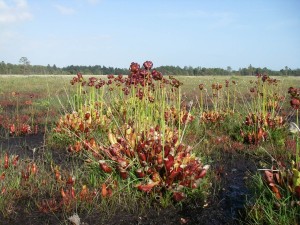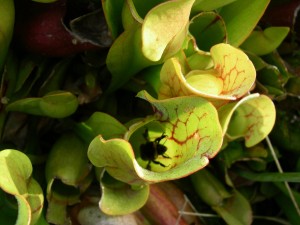Recent work from Bournemouth University indicates that these non-native pitcher plants are consuming bumblebees but their current impact is limited.
In a bog in Dorset grow a small patch of the strange, alien like forms of the invasive pitcher plant Sarracenia purpurea. It is adapted to the poor soils of American wetlands and therefore supplements its diet with insect prey, luring them in with the promise of sweet nectar.

Photo by Anita Diaz
It is not every day that an invasive plant species also counts as predator and this can prove a challenge for management. The pitchers are one such case and a research team from Bournemouth University have been investigating the impact these invaders are having on the native bumblebees. They have done this by looking at the contents of the pitcher’s
traps.
Their results showed that no rare bumblebee species were found in the sampled pitchers from 2012-14. In 2013 the pitchers were found to be consuming a considerable amount of bumblebees (101 bees in the 170 pitchers sampled), however, very few bumblebees were caught in 2012 and 2014. Bumblebees also seem to be attracted to pitchers where the pitchers grow in higher density, suggesting that the bumblebees are treating the pitchers as they would another floral resource, despite individuals being trapped.
It is quite probable that the bumblebees feed off the flowers of the pitcher plants, as they do in the plant’s native America, as well as the nectar from traps. It is also likely you see flowers online due to the low capture rate of pitchers (around 1 in 100 insects get caught), and the majority of visiting bumblebees are getting a ‘free meal’ in a bog habitat with limited other resources.
‘It could very well be that the sugar rich solution produced by the pitchers, coupled with the low trapping rate of pitchers, is worth the risk to our native bees’ Dr Liz Franklin

Photo by Anita Diaz
It is important to prevent the spread of invasive plants like S. purpurea, as they can have a drastic impact on our native plant life and wildlife, however in a sensitive bog habitat with Site of Special Scientific Interest (SSSI) status, removal could cause severe damage to the native habitat and risk the further spread of the invasive. It is hoped that this work will help inform when and where management of S. purpurea is needed in its invasive populations around Europe
Although further work needs to be done on the interactions between invasive pitcher plants and their native prey, the pitchers might not be as bad for our bogs and their fauna as first thought, although it will be important to keep an eye on them.
Want to find out more, visit our open access article











 Dr. Ashraf cited on ‘Modest Fashion’ in The Guardian
Dr. Ashraf cited on ‘Modest Fashion’ in The Guardian NIHR-funded research launches website
NIHR-funded research launches website Academics write for newspaper in Nepal
Academics write for newspaper in Nepal New paper published on disability in women & girls
New paper published on disability in women & girls MSCA Postdoctoral Fellowships 2025 Call
MSCA Postdoctoral Fellowships 2025 Call ERC Advanced Grant 2025 Webinar
ERC Advanced Grant 2025 Webinar Horizon Europe Work Programme 2025 Published
Horizon Europe Work Programme 2025 Published Horizon Europe 2025 Work Programme pre-Published
Horizon Europe 2025 Work Programme pre-Published Update on UKRO services
Update on UKRO services European research project exploring use of ‘virtual twins’ to better manage metabolic associated fatty liver disease
European research project exploring use of ‘virtual twins’ to better manage metabolic associated fatty liver disease